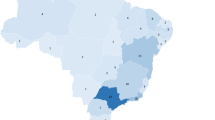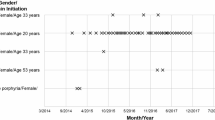Abstract
In Germany, analyses of clinical and laboratory features of patients with acute porphyrias are only available for hereditary coproporphyria (HCP) but not with other acute porphyrias, acute intermittent porphyria (AIP) and variegate porphyria (VP). The aim of the study was to analyze a large cohort of patients with particular focus upon quality of life aspects. Sixty-two individuals from separate families with acute porphyrias (57 AIP, 5 VP) were included into an observational study collecting biochemical, genetic, and clinical data. A questionnaire was designed to complete anamnestic information and to assess the influence on quality of life. Most frequent signs and symptoms or laboratory abnormalities were abdominal colicky pain, red coloration of urine, and hyponatremia. Depression or anxiety was reported by 61% or 52% individuals, respectively. Fatigue was mentioned as the most quality of life-limiting symptom. In 59/61 patients, mutations could be identified. 44% (20/45) had to be admitted to an intensive care unit. Heme arginate was used in 64% (29/45) of patients for treatment of acute attacks at least once and in 33% for long-term treatment with high frequency of administration. Serum creatinine values increased in 47% (7/17) of the patients with recurrent attacks. Our analysis confirms a substantial influence of the diseases on the quality of life on patients. Percentages of urine discoloration and intensive care unit admissions were much higher than in other reports. Long-term treatment with heme arginate requires careful monitoring of iron status and renal values.



Similar content being viewed by others
Abbreviations
- 5-ALA:
-
5-aminolevulinic acid
- PBG:
-
porphobilinogen
- siRNA:
-
silencing RNA
- AIP:
-
acute intermittent porphyria
- HCP:
-
hereditary coproporphyria
- VP:
-
variegate porphyria
- FMF:
-
familial Mediterranean fever
References
Bissell DM, Anderson KE, Bonkovsky HL (2017) Porphyria. N Engl J Med 377:862–872
Kühnel A, Gross U, Doss MO (2000) Hereditary coproporphyria in Germany: clinical-biochemical studies in 53 patients. Clin Biochem 33:465–473
Bonkovsky H, Maddukuri VC, Yazici C, Anderson KE, Bissell DM, Bloomer JR, Phillips JD, Naik H, Peter I, Baillargeon G, Bossi K, Gandolfo L, Light C, Bishop D, Desnick RJ (2014) Acute porphyrias in the USA: features of 108 subjects from porphyrias consortium. Amer J Med 127:1233–1241
Puy H, Deybach JC, Lamoril J et al (1997) Molecular epidemiology and diagnosis of PBG deaminase gene defects in acute intermittent porphyria. Am J Hum Gen 60:1373–1383
Cerbino GN, Gerez EN, Varela LS et al (2015) Acute intermittent porphyria in Argentina: an update. Biomed Res Int 2015:946387. https://doi.org/10.1155/2015/946387
Herrero C, Badenas C, Aguilera P, To-Figueras J (2015) Acute intermittent porphyria: Long-term follow up of 35 patients. Med Clín (English Edition) 145:332–337
Bylesjö I, Wikberg A, Andersson C (2009) Clinical aspects of acute intermittent porphyria in Northern Sweden: a population-based study. Scand J Clin Invest 69:612–618
Schneider-Yin X, Harms J, Minder EI (2009) Porphyria in Switzerland, 15 years experience. Swiss Med Wkly 139:198–206
Hift RJ, Meissner PN (2005) An analysis of 112 acute porphyric attacks in Cape Town, South Africa: evidence that acute intermittent porphyria and variegate porphyria differ in susceptibility and severity. Medicine 84:48–60
Di Pierro E, Ventura P, Brancaleoni V et al (2009) Clinical, biochemical and genetic characteristics of variegate porphyria in Italy. Cell Mol Biol (Noisy-le-grand) 55:79–88
von und zu Fraunberg M, Pischik E, Udd L, Kauppinen R (2005) Clinical and biochemical characteristics and genotype-phenotype correlation in 143 Finnish and Russian patients with acute intermittent porphyria. Medicine 84:35–47
Yang J, Chen Q, Yang H et al (2016) Clinical and laboratory features of acute porphyria: a study of 36 subjects in a Chinese tertiary referral center. Biomed Res Int 2016:3927635. https://doi.org/10.1155/2016/3927635
Kumar S, Bhalla A, Sharma N, Dhibar DP, Kumari S, Varma S (2017) Clinical, biochemical characteristics and hospital outcome of acute intermittent porphyria patients: a descriptive study from North India. Ann Indian Acad Neurol 20:263–269
Stauch Th, Doss M, Petrides PE et al (2017) Determination of reference ranges and cut-off values for the creatinine ratios of porphyrin precursors 5-aminolevulinic acid and porphobilinogen for the reliable evaluation of urine spot samples. International Congress of Porphyrins and Porphyrias, Bordeaux, France, June 2017
Lin CN, Huang YC, Ro LS et al (2018) Validation and evaluation of two porphobilinogen deaminase assays for diagnosis of acute intermittent porphyria. Clin Chim Acta 479:1–6
Brasch L, Zang C, Haverkamp T, Petrides PE (2004) Molecular analysis of acute intermittent porphyria: mutation screening in 20 patients in Germany reveals 11 novel mutations. Blood Cells Mol Dis 32:309–314
Siegel FP, Tauscher J, Petrides PE (2013) Aquagenic pruritus in polycythemia vera: characteristics and influence of life in 441 patients. Am J Hematol 88:665–669
Petrides PE (2011) Simultaneous presence of acute intermittent porphyria and familial Mediterranean fever in a Turkish female patient. International Porphyrins and Porphyrias Meeting Cardiff, UK, 10-14.April 2011
Petrides PE (1998) Acute intermittent porphyria: mutation analysis and identification of gene carriers in a German kindred by PCR-DGGE analysis. Skin Pharmacol Appl Skin Physiol 11:374–380
Haverkamp T, Bronisch O, Knösel T, Weichert W, Stauch T, Beykirch M, Petrides PE (2019) Heterogeneous molecular behaviour in liver and gall bladder tumors of patients with acute intermittent porphyria. International Congress on Porphyrins and Porphyrias, Milan, Italy, 8-11. Sept.2019
Grath S, Parsch J (2016) Sex biased gene expression. Annu Rev Genet 50:29–44
Stewart MF (2012) Review of hepatocellular cancer, hypertension and renal impairment as late complications of acute porphyria and recommendations for patient follow up. J Clin Pathol 65:976–980
Pallet N, Karras A, Thervet E, Gouya L, Karim Z, Puy H (2018) Porphyria and kidney diseases. Clin Kidney J 11:191–197
Pandey U, Dixit VK (2013) Acute intermittent porphyria in pregnancy: a case report and review of the literature. J Indian Med Assoc 11:850–851
Tollånes MC, Aarsand AK, Sandberg S (2011) Excess risk of adverse pregnancy outcomes in women with porphyria: a population based cohort study. J Inherit Metab Dis 34:217–223
Simon A, Pompilus F , Querbes W et al. (2018) Patient perspective on acute intermittent porphyria with frequent attacks: a disease with intermittent and chronic manifestations. Patient 11: 527–537
Millward LM, Kelly P, Deacon A, Senior V, Peters TJ (2001) Self-rated psychosocial consequences and quality of life in the acute porphyrias. J Inherit Metab Dis 24:733–747
Millward LM, Kelly P, King A, Peters TJ (2005) Anxiety and depression in the acute porphyrias. J Inherit Metab Dis 28:1099–1107
Naik H, Stoecker M, Sanderson SC, Balwani M, Desnick RJ (2016) Experiences and concerns of patients with recurrent attacks of acute hepatic porphyria: a qualitative study. Mol Genet Metab 119:278–283
Yang J, Zhu T, Zhao Y et al (2018) Acute intermittent porphyria in the north of China: the acute attack effect on quality of life and psychological condition. Biomed Res Int 2018:3216802. https://doi.org/10.1155/2018/3216802 eCollection 2018
Gouya L, Ventura P, Balwani M et al. (2019) EXPLORE: a prospective multinational natural history study of patients with acute hepatic porphyrias (AHP) with recurrent attacks. Hepatology Sept 12. https://doi.org/10.1002/hep.30936
Schmitt C, Lenglet H, Yu A, Delaby C, Benecke A, Lefebvre T, Letteron P, Paradis V, Wahlin S, Sandberg S, Harper P, Sardh E, Sandvik AK, Hov JR, Aarsand AK, Chiche L, Bazille C, Scoazec JY, To-Figueras J, Carrascal M, Abian J, Mirmiran A, Karim Z, Deybach JC, Puy H, Peoc'h K, Manceau H, Gouya L (2018) Recurrent attacks of acute hepatic porphyria: major role of the chronic inflammatory response in the liver. J Intern Med 284:78–91
Sardh E, Harper P, Balwani M et al (2019) Phase 1 trial of an RNA interference therapy for acute intermittent porphyria. N Engl J Med 380:549–558
Jian L, Berraondo P, Jerico D et al (2018) Systemic messenger RNA as an etiological treatment for acute intermittent porphyria. Nat Med 24:1899–1908
Acknowledgments
We thank the patients for providing information through personal interviews and QOL questionnaires and their informed consent.
Funding
This study was not funded.
Author information
Authors and Affiliations
Corresponding author
Ethics declarations
Conflict of interest
The authors declare that they have no conflict of interest.
Ethical approval
This article does not contain any studies with human participants performed by any of the authors.Informed consent
Informed consent was obtained from all individual participants included in the study.
Additional information
Publisher’s note
Springer Nature remains neutral with regard to jurisdictional claims in published maps and institutional affiliations.
Rights and permissions
About this article
Cite this article
Bronisch, O., Stauch, T., Haverkamp, T. et al. Acute porphyrias: a German monocentric study of the biochemical, molecular genetic, and clinical data of 62 families. Ann Hematol 98, 2683–2691 (2019). https://doi.org/10.1007/s00277-019-03831-7
Received:
Accepted:
Published:
Issue Date:
DOI: https://doi.org/10.1007/s00277-019-03831-7




